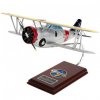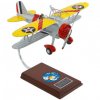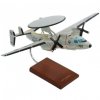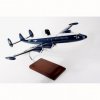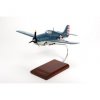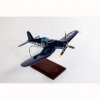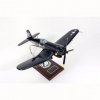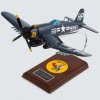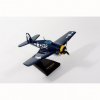"The G-5/FF-1 Fifi is a naval fighter aircraft manufactured by Grumman and was designed by Leroy Grumman. The primary users and operators of the FF-1 are the United States NAvy, Spanish Republican Air Force and the Royal Canadian Air Force. In June 1933, FF-1s were delivered to Fighter Squadron VF-5B of the USS Lexington. In service, the FF-1 became known as Fifi. FF-1, together with the SF-1 were withdrawn from first-line US Navy squadrons by the end of 1936 and reallocated to reserve units. In the late 1940, most of the FF-1s are still in service. The FF-1 has a crew of 1. It has a maximum speed of 207 mph and a range of 685 mi. Armament includes 2 .30 M1919 Browning machine guns and a 100 lb bomb. It incorporates a Wright R-1820-78 Cyclone radial engine. There are 120 FF-1s built. "
Scale: 1/24 scale model
Wing Span: 17.75
Length: 12.25
ACFF1TE
|
"The F9 Sparrowhawk is a parasite fighter type designed to be deployed from a larger aircraft such as an airship or bomber and is ideal for service in the fighter complement of large rigid-framed airships for its small size. Its primary duty is reconnaissance. The F9 is carried by the US Navy airships USS Akron and USS Macon. The Akron was reported to have a complement of three F9s, while the Macon was found at its underwater resting place with four in its hangar. Currently, only one F9 Sparrowhawk still exists and it resides in the Smithsonian Institution's National Air and Space Museum. "
Wing Span: 15.25
Length: 21.13
ACSF9CTE
|
"The E-2 Hawkeye is an aircraft carrier-based tactical Airborne Early Warning (AEW) aircraft and is used for missions including surface surveillance coordination, strike and interceptor control, search and rescue guidance and communications relay. It was manufactured by Grumman Aerospace Corporation and Northrop Grumman. In 1964, after replacing the E-1, the Hawkeye has been the eyes of the fleet and has served the US Navy around the world. The E-2Cs has provided the command and control for successful operations during the Persian Gulf War. The original E-2C Hawkeye became operational in 1973 and has been through several upgrade programs since then. The E-2 aircraft served and have worked extremely effective with US law enforcement agencies in drug interdictions. During the late 1980s and the early 1990s, the E-2C Hawkeye has supported numerous naval engagements including the 1985 intercept of the aircraft containing the hijackers of the liner Achille Lauro. It has also participated in the strikes against Libya in 1986. The E-2C Hawkeye has a maximum speed of 374 mph and a range of 200 nauticla miles. It has a crew of five, including equipment operators. The primary users and operators of the E-2C Hawkeyes are the United States Navy, French Navy, Israeli Air Force and the Japan Air Self-Defense Force. "
Wing Span: 20
Length: 15
AE2CT
|
The Grumman E-2 Hawkeye is an American all-weather, aircraft carrier-based tactical Airborne Early Warning (AEW) aircraft. The twin turboprop aircraft was designed and developed in the 1950s by Grumman for the United States Navy as a replacement for the E-1 Tracer. The aircraft has been progressively updated with the latest variant, the E-2D, first flying in 2007.
Scale: 1/48 scale model
Wing Span: 20
Length: 15
AE2DT
Pre-Order! Available: December
|
"The EC-121 is an airborne early warning aircraft manufactured by Lockheed. The WV-2 is the main USN variant. From 1956 to 1954, WV-2s served in two barrier forces, each coast of the North American continent. Its aim was to extend early warning coverage against surprise attack of Soviet bomber and missile. On September 1965, Barrier Force operations were discontinued, however, Navy EC-121 operations continued until 1975 in four other squadrons. EC-121M was operated by VQ-1 and VQ-2 at NAS Atsugi, Japan and Naval Station Rota, Spain respectively. EC-121M, also known as Rivet Top, is a modified EC-121K and it carried the QRC-248 newly installed in the College Eye aircraft and has electronic interrogators capable of reading two additional Soviet transponders, the SRO-1 and SOD-57. EC-121M's electronics were custom-built. The most important upgrade was the installation of the highly secret Rivet Gym. The EC-121M Rivet Top prototype moved to Korat along with the College Eye Task Force in October 1967 and was scheduled to return to the United States in February 1968 but it remained at Korat until 1969. The primary users and operators of the EC-121 are the United States Air Force and the United States Navy. There's a total of 232 EC-121s built. "
Scale: 1/72 scale model
Wing Span: 19.25
Length: 20.25
AEC121MT
|
"The F4F-4 Wildcat entered the US Navy service in 1942. The carrier has six guns and folding wings that allow more people to get on board. Although it performed the most combat service during the early war days, F4F Wildcat was less popular with the American pilots because of the additional guns which caused the decrease of firing time as the same amount of ammunition was spread to it. The F4F-4 can accommodate only 1 crew. It has a length of 28 ft and 9 in or 8.8 m; wingspan of 38 ft or 11.6 m; height of 9 ft and 2.5 in or 2.8 m; and weight of 5,760 lb (when empty). F4F Wildcat has a maximum speed of 320mph and rate of climbing 1,950 ft/min. It also has six M2 Browning machine guns and two bombs. The F4F-4 broke the dominance of the Japanese Zero. Grumman became known as the Ironworks because of its strongly designed aircrafts that were tremendously damaged but were still able to fly home. "
Scale: 1/32 scale model
Wing Span: 10.75
Length: 14.25
AF4FT
|
"The F4U Corsair was a single-engine aircraft. It was conceived to be using the most powerful engine and the largest propeller a fighter aircraft ever had. The long propeller blades caused ground clearance problems, while the “W” shaped wings helped reduce the length required for the landing gear to provide good visibility on the sides. The F4U Corsair was called the “Ensign Eliminator”, a strong engine torque which didn’t make it an easy plane to land. The F4U Corsair aircraft went into production in 1942. There were different World War II aircraft variants and the F4U-1D Corsair was one of them. The F4U-1D was a fighter aircraft that served the US Navy during World War II and Korean War. It became the first United States single-engine production aircraft that was capable of reaching 400 mph. The F4U-1D was built in parallel with the F4U-1C, a variant that was in production in 1943 but entered the service in 1945. The F4U-1D Corsair was introduced in 1944. It was the Fighter-Bomber variant because compared to other variants it had a double payload of rockets which was exactly what the US Navy needed. It weighs 4100 kg/9040 lbs when empty and 6400 kg/14100 lbs when full; its engine is Pratt & Whitney R-2800 Double Wasp, 18 cylinders and power of 2200 hp; the aircraft’s armament is 6 x 12.7 mm (.50cal) machine guns in the wings; and max speed of 635 km/h and ceiling of 11280 m. "
Wing Span: 16.25
Length: 12.25
AF4U1NT
|
"The F4U Corsair has proven to the most capable capable carrier based fighter of World War II. In June 1942, the first production of the F4U-1s were delivered. The famous ""Black Sheep"" squadron of book and TV series fame immortalized the Corsair in the blue South Pacific skies. The F4U-4 was the definitive version of the F4U Corsair. It features a four-bladed Hamilton Standard Hydromatic propeller, a new cockpit layout, a clear view sliding hood, a two stage turbo-supercharged engine and under wing attachment points for 8-5 inch rockets or bombs. Most F4U-4s retained the standard armament of 6- .50 caliber wing mounted machine guns. The F4U-4 incorporates a Pratt & Whitney R-2000-18W. It has a maximum speed of 435 mph at 15,000 ft and a range of 1,005 miles at 214 mph at 15,000 ft. The Corsair was one of the great fighters of World War II and was proven much later in its service during the Korean War."
Wing Span: 19
Length: 15.25
AF4U4MTS
|
"The F4U Corsair was the result of a 1938 United States Navy (USN) requirement for a new carrier aircraft that could match the performance of the best land and carrier-based fighter planes. Designed by Rex Buren Beisel and manufactured by Chance Vought, it was made to carry the most powerful engine and largest diameter propeller ever built at that time. Although designed as a carrier fighter for the USN, concerns about its landing and visibility characteristics led it to be used initially by the United States Marine Corps (USMC), which operated on land-based runways. In March 1943, the Marines introduced the aircraft to its debut combat. Eventually it was put into service with the USN in January 1944, after the British proved that it was able to operate safely from carriers. The plane was not slow to prove its fighting ability and succeeded in gunning down 2,140 enemy aircraft while losing only 189 F4Us during World War II. Consequently, 24 Corsair pilots became air aces. The Corsair was given the nicknames “The Sweetheart of the Marianas” and “The Angel of Okinawa” by allied ground forces. The Japanese troops dubbed it “Whistling Death” because of the sound that it made during dive-bombing or strafing runs. The F4U-4 was the last variant to be produced during World War II, entering service just four months before the end of hostilities. With a rate-of-climb of nearly 4,000 feet per minute and a service ceiling of 41,500 feet, it was the Navy’s answer to the much improved Japanese fighters that were arriving in the Pacific. In addition to a new propeller, the F4U-4 had a completely redesigned cockpit, a new canopy for improved bubble effect, a new armor-plated bucket seat, and regrouped instruments. Improved fighter-bomber capabilities were made possible by putting rocket stations on the outer wing panels. The F4U-4 saw combat in Korea between 1950 and 1953. "
Wing Span: 16.25
Length: 12.25
AF4U4TE
|
"The Grumman F6F Hellcat was a fighter aircraft descended from the earlier F4F Wildcat, but was a completely new design sharing only a familial resemblance to the Wildcat. Some tagged it as ""Wildcat's big brother"". The name Hellcat was eventually retained in early 1943 for the sake of simplicity. The Hellcat proved to be the most successful aircraft in naval history, destroying 5,171 aircraft in service with the U.S. Navy and U.S. Marine Corps, plus 52 with the Royal Navy's Fleet Air Arm during World War II. The first production aircraft off the line, designated F6F3s, flew on October 3, 1942 with the type reaching operational readiness with VF-9 on USS Essex i February 1943. Two night fighter subvariants of the F6F-3 were also developed. The F6F-3E, converted from standard -3 frames, featured the AN/APS-4 radar in a fairing in the starboard wing. The later F6F-3N, first seen in July 1943, was fitted with the AN/APS-6 radar in a similar fairing. Hellcat night fighters had their first action in November 1943. The first real test of the F6F-3 against the Zero came a few months later in December when a groupof about a hundred Hellcats ripped into a like number of Japanese planes of which half were Zeros. In the ensuing battle, 28 of the Zeros were splashed for a total loss to the Hellcats of 3 planes. Many U.S. Navy pilots had good cause to refer to the Hellcat as the ""Aluminum Tank"". With its six.50 caliber Browning M2 machine guns, it could spit out a veritable hail of destruction which no Japanese adversary could hope to survive. After the war, Japanese pilots related their fear and dread each time they were engaged by the Hellcat. The Hellcat aircraft was rapidly phased out of front line service, retiring in 1954 as a night-fighter in composite squadrons. "
Wing Span: 12.25
Length: 16
AF6FT
|
"The date was September 1, 1943 when the Hellcat first saw action against the Japanese when fighters off the USS Independence (CVL-22) shot down a snooping seaplane. After which at 23rd of November, Hellcats engaged Japanese aircraft over Tarawa, shooting down a claimed 30 Mitsubishi Zeros for the loss of one F6F. On November 11, 1943, Hellcats were engaged in day-long fights with many Japanese aircraft including A6M Zeros, claiming more than 100 victories while losing few F6Fs over Rabaul, New Britain. The ""Thach Weave"" had developed into a formation tactic by that time. Each time an enemy fighter made a run at a section of US fighters, the pursued Hellcats would break towards the opposing formation that would cross over and force the Japanese to break off or expose themselves to the Hellcat's weapons. The ""wingman"" tactics started which are still used to this day, allowing less maneuverable US aircraft such as the Hellcat to deal with much more nimble Japanese opponents. Hellcats were involved in practically all engagements with Japanese air power from that point onward. Navy and Marine F6Fs flew 66,530 combat sorties (45% of all fighter sorties of the war, 62,386 sorties were flown from aircraft carriers) and destroyed 5,163 enemy aircraft (56% of all Naval/Marine air victories of the war) at a cost of 270 Hellcats (an overall kill-to-loss ratio of 19:1).The aircraft performed well against the best Japanese opponents with a 13:1 kill ratio against Mitsubishi A6M, 9.5:1 against Nakajima Ki-84, 28:0 against Kawanishi N1K-J, and 3.7:1 against Mitsubishi J2M during the last year of the war. In the ground attack role, Hellcats dropped 6,503 tons of bombs. "
Scale: 1/48 scale model
Wing Span: 10.5
Length: 8.5
AF6FTR
|
"The F-82 Twin Mustang is a heavy fighter manufactured by North American Aviation and was based on the P-51 Mustang. The F-82 was originally designed as a long-range fighter in World War II though its role was changed to night-fighting. On June 11, 1948, United States Air Force eliminated the P designation for pursuit and replaced it with F which pertains to fighter. The night fighter versions which were designated the F-82F/G required numerous modifications such as the removal of the right side cockpit to be replaced with a radar operator's position lacking flight controls. The most significant modification was the addition of a long radar pod attached to the underside of the center wing. The first F-82G that became operational was in late 1948. In mid 1949, F-82 became widespread and some of the E/F/G models were used by the United States Air Force. F-82Gs were also deployed to the 347th Fighter Group in Japan. The F-82G, though it missed its opportunity to fight in World War II, it distinguished itself during the Korean War. The F-82G has a crew of two. It has a maximum speed of 400 knots and a range of 1,950 nm. It incorporates 2 Allison V-1710-143/145 liquid-cooled V12 engines. The primary user and operator of the F-82 Mustang is the United States Air Force. There's a total of 270 F-82s built. Currently, there are three F-82s known to have existed. "
Scale: 1/32 scale model
Wing Span: 16.25
Length: 20.5
AF82TE
|
"The C-130 Hercules is a four-engine turboprop cargo aircraft and the main tactical airlifter for many military forces worldwide. Over 40 models and variants of the Hercules serve with more than 50 nations. In December 2006 the C-130 became the fourth aircraft (after the English Electric Canberra in May 2001, B-52 Stratofortress in January 2005 and the Tupolev Tu-95 in January 2006) to mark 50 years of continuous use with its original primary customer, the United States Air Force (USAF). The C-130 is capable of short takeoffs and landings from unprepared runways. The C-130 was originally designed as a troop, medical evacuation and cargo transport aircraft. The versatile airframe has found uses in a variety of other roles, including as a gunship, and for airborne assault, search and rescue, scientific research support, weather reconnaissance, aerial refuelling and aerial firefighting. The C-130H model has updated Allison T56-A-15 turboprops, a redesigned outer wing, updated avionics and other minor improvements. Later H models had a new, fatigue-life-improved, center wing that was retro-fitted to many earlier H-models. The H model remains in widespread use with the US Air Force (USAF) and many foreign air forces. Initial deliveries began in 1964 (to the RNZAF), remaining in production until 1996. An improved C-130H was introduced in 1974."
Wing Span: 16
Length: 12
AC1302T
|
"The Blue Angels, a U.S. Navy Flight Demonstration Squadron was formed to enhance the Navy and Marine Corps. It started in 1946 and is known as the first officially sanctioned military aerial demonstration team in the world. The Blue Angels fly three aircrafts in formation first and then four and now six per show. With the aerobatic stunts they perform, the group became known worldwide. The team was first led by Lt. Cdr. Voris. The team also operates a Marine Corps C-139T Hercules known as “Fat Albert”. It was designed to transport 25,000lbs of equipment and 45 personnel from one air show to another. As soon as Fat Albert arrives in the site, it is prepared for its dynamic demonstration. The widely known demonstration of Fat Albert is the JATO or Jet Assisted Take-Off. Whenever the aircraft sets off for a highspeed flat pass the words “United States Marine Corps” embossed across the Fat Albert’s skin is seen from below. The Fat Albert has the privilege to open each Blue Angel performance with its great demonstration flight. It is said to be operated by the US Marine Corps and its crew only consisted of USMC personnel."
Scale: 1/84 scale model
Wing Span: 19
Length: 14
AC130BA
|
"The HC-130 Hercules is a long-range surveillance and transport, fixed-wing aircraft that is used to perform search and rescue operations, marine environmental protection, military readiness, enforcement of laws and treaties including illegal drug interdiction, and International Ice Patrol missions, as well as cargo and personnel transportation. The aircraft took its first flight on August 23, 1954. The HC-130 is an extended-range, combat rescue version of the C-130 transport aircraft. Its main mission is to provide air refueling for rescue helicopters. The aircraft can surpass 2,600 miles in low-altitude flying with mission strength of up to 14 hours. The aircraft is equipped with a ten tube flare launching system and scanner windows. Guidance aids such as GPS, Inertial Navigation System, and radar improves the HC-130s performance during long range maritime patrols. "
Wing Span: 16
Length: 14
AC130CGT
|

